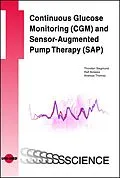Continuous Glucose Monitoring (CGM) describes the glucose profile between blood glucose measurements undertaken at specific times and thus represents the perfect symbiosis with conventional blood glucose measurement. In the context of diagnostic investigation, it has resulted in a surprising extension of the picture on the treatment of diabetes. Beyond this context of diagnostic application, the continuous display of the current glucose level makes possible subtle regulation of insulin therapy, especially insulin pump therapy. Several clinical studies have provided significant proof of the advantage of Sensor-Augmented Pump Therapy (SAP). The focus of this book is the new dimension of "glucose dynamics". The discussion begins with the technological bases of CGM and SAP, it encompasses relevant scientific data/studies and extends to the clinical application. Practical examples and the interpretation of glucose curves ensure that the material is relevant to clinical practice. The authors of this book have an extensive wealth of knowledge and experience with CGM and SAP. With this book, they have for the first time compiled a practical monograph on this subject area, one that is not yet present in the literature. The book is a "must" on a highly relevant current and future aspect of diabetology.
Inhalt
1.State of the art in the technical development of modern insulin pumps101.1.Historical development of insulin pumps101.2.Change in the indications for CSII121.3.Characteristics and functionality of modern insulin pumps131.3.1.Currently available insulin pumps131.3.2.The "treasures of insulin pump therapy"131.3.2.1.Overview131.3.2.2."CSII treasure number 1": multibasal rate administration161.3.2.3."CSII treasure number 2": different bolus options171.3.2.4."CSII treasure number 3": bolus calculator171.3.3.Differences in the functions of modern insulin pumps181.3.4.Use of the standard function of modern insulin pumps191.3.5.Association of CSII and CGM for SAP201.3.6."Patch pumps" " insulin pumps without catheters211.3.7.Implanted insulin pumps221.4.Summary231.5.References232.Technical developments in the field of continuous glucose monitoring262.1.Principles of the detection of glucose in blood or in interstitial fluid262.2.Basic possibilities for continuous glucose monitoring (CGM)282.2.1.Overview282.2.2.Glucose monitoring in interstitial fluid with minimally invasive sensors292.2.3.Glucose monitoring with implantable glucose sensors302.2.4.Glucose monitoring with non-invasive glucose sensors312.3.Properties and comparison of the available systems of the needle sensor type332.4.References383.Characteristics of continuous glucose monitoring (CGM)423.1.Methods of CGM423.1.1.Distinction between diagnostic and therapeutic use423.1.2.Diagnostic application of CGM423.1.3.Use of CGM in everyday treatment control443.2.Differences in CGM in relation to self-monitoring of blood glucose (SMBG)463.2.1.Uninterrupted measurement and visualisation of the dynamic glucose profile as a result of CGM463.2.2.Consequences of CGM measurement in interstitial fluid463.2.3.Calibration of CGM473.2.4.Setting of alarms and pre-alarms493.3.Utilisation of software for the display, analysis and evaluation of CGM measurements503.3.1.Overview503.3.2.Displays in CareLink" software513.3.2.1.CareLink" PERSONAL513.3.2.2.CareLink" PRO523.3.2.3.CareLink" iPro"553.3.3.Summary563.4.References564.Aspects of the combination of glucose sensor and insulin pump624.1.Potential of the combination of insulin pump and sensor624.2.Support of CGM when starting a patient on insulin pump therapy624.3.Utilisation of CGM profiles for training pump wearers634.4.Influence of CGM on the full exploitation of the extended functions of modern insulin pumps644.5.CGM as proof of successful pump initiation for the medical insurance companies654.6.Sensor-augmented pump therapy (SAP)664.7.Interconnection of glucose sensor and insulin pump for the closed loop system694.8.References725.Problem analysis from glucose profiles recorded with CGM765.1.Overview765.2.The magic of blood glucose and what interstitial glucose tells us about it765.3.Hypoglycaemic episodes775.3.1.Forensics with an evolutionary biological background775.3.2.Classification of hypoglycaemia based on its symptoms785.3.3.Clinical pathology of compromised counter-regulation795.4.Use of CGM for the analysis of the glucose profile and detection of hypoglycaemia795.5.Characteristic details in the CGM profiles815.6."Criminology" of the glucose level835.6.1.Fine analysis of glucose profiles by "forensic detective work"835.6.2.Criminology of nocturnal hypoglycaemia and its consequences845.6.2.1.Possible motive and opportunity845.6.2.2.From clues to the profile of the offender845.6.2.3.Catching red-handed855.6.2.4.Scene of the crime and search for tracks (standard pattern)865.6.2.5.Disguises and deception875.6.2.6.The usual suspects895.6.2.7.Key points for "criminology"895.6.3.Example of a patient905.7.References936.Getting started on sensor-augmented pump therapy966.1.Overview966.2.Insulin selection966.3.Insulin dosage976.3.1.Daily insulin requirement and its division976.3.2.Basal rate986.3.2.1.Determination of the basal rate986.3.2.2.Checking the basal rate986.3.2.3.Use of various basal rate profiles986.3.2.4.Temporary basal rate996.4.Bolus delivery996.4.1.Bolus management996.4.2.Bolus options1006.4.3.Correction/bolus calculator, BolusWizard®1026.5.References1047.Clinical evidence on CSII, CGM and SAP1087.1.Evidence-based medicine (EBM): how far can this be demanded for CSII, CGM and SAP?1087.2.Clinical evidence on insulin pump therapy CSII1107.2.1.Overview1107.2.2.Experimental and clinical results of CSII in patients with type 1 diabetes1107.2.3.Experimental and clinical results for CSII in patients with type 2 diabetes1167.2.4.Meta-analyses on CSII1177.3.Clinical evidence for continuous glucose monitoring (CGM)1197.4.Experimental and clinical evidence for sensor-augmented pump therapy (SAP)1237.5.References1278.Is continuous glucose monitoring leading to a paradigm shift in diabetology?1348.1.Empirical diabetology1348.2.Diabetology based on data1358.2.1.HbA1c and glucose excursions1358.2.2.The glucose pentagon model1368.3.Diabetology based on data in everyday practice1388.4.Summary1398.5.References140Index142
